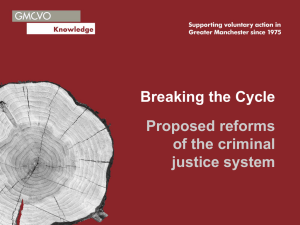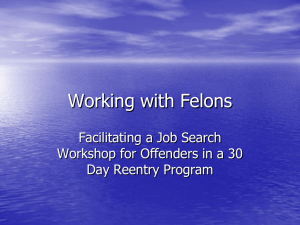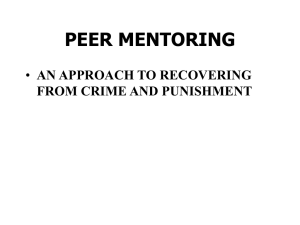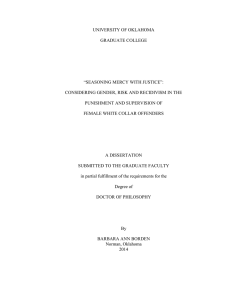White collar offenders
advertisement
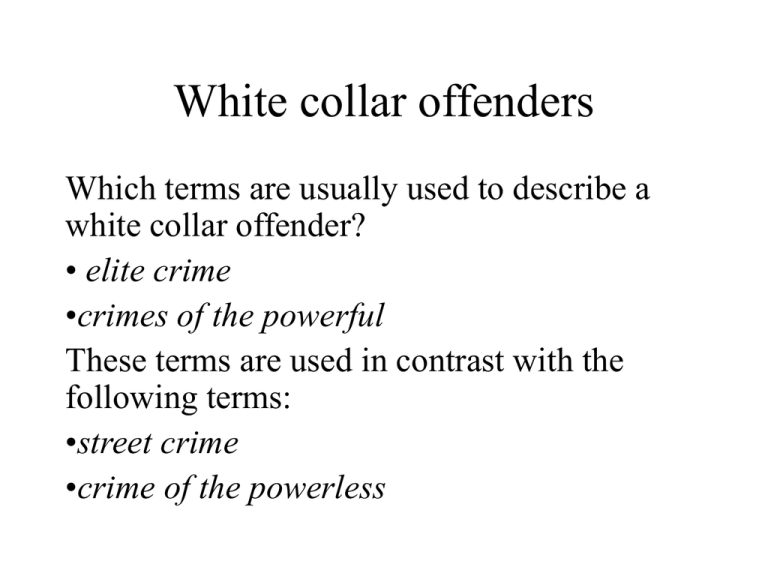
White collar offenders Which terms are usually used to describe a white collar offender? • elite crime •crimes of the powerful These terms are used in contrast with the following terms: •street crime •crime of the powerless Both in rhetoric and research, the white collar offender has been pictured as the polar opposite of the common criminal …. As much as we have come to see street crime primarily as the work of disadvantaged young men from broken families and decaying neighbourhoods, white collar crime has been linked to the advantaged older men from stable homes living in well-kept communities. (Weisburd et al., 1991) The stereotype “one law for rich and one law for poor” It is often assumed that high status offenders are treated differently by law enforcers In the past, “entrepreneurs” did not enjoy a universally respectable status, having been seen as “mavericks”. Business and commercial groups were not previously regarded as part of the upper class establishment Which cases will the media be more interested in? Cases in which the “extravagant lifestyle” of offenders can be contrasted with the suffering they have imposed on their innocent victims. Major themes in the media are •the “fall from grace” of wealthy ad powerful pillars of the community •Cases involving major institutions whose names are immediately recognizable The Guinness share-trading fraud was a famous British Business scandal of the 1980s. It involved an attempt to manipulate the stock market on a massive scale to inflate the price of Guinness shares and thereby assist a £2.7 billion take-over bid for the Scottish drinks company Distillers. Ernest Saunders, Geald Ronson, Jack Lyons and Anthony Parnes, the so-called "Guinness four", were charged, paid heavy fines and, with the exception of Lyons, who was suffering from ill-health, served prison sentences later reduced on appeal Martha Stewart • Martha Stewart is an author, editor and commercial spokesperson. Over more than two decades as a prominent editor of homemaking magazines, host of homemaking television shows, and prominent commercial spokesperson Stewart rose to international fame. In 2002, she was accused of insider trading and other crimes relating to statements that she made to investigators, and in 2004 she was convicted on four counts of lying to investigators and obstruction of Justice. Her syndicated television show was cancelled and she was forced to step down from her role as CEO and chairwoman of MSLO for a non-executive role, and resigned her position as a board member for Revlon and the New York Stock Exchange. Stewart surprised many when she pleaded guilty to lying to federal investigators in 2004, and accepted a 5-month prison sentence which she served at Alderson Federal Prison Camp. She was released on March 4, 2005, after which she was placed under supervised release and required to wear an ankle bracelet for an additional 5 months. Major corporate scandals • • • • • • Enron Tyco International Worldcom Parmalat Cirio Lloyd’s of London and the Insurance Industry in general Some cases do capture the attention of the public because of the high status of the victims, as in the case of Nick Leeson, in which the list of the victims included senior executives of the bank and high status investors as the Royal Family Nicholas Leeson was a derivatives trader whose unsupervised speculative trading caused the collapse of Barings Bank, the United Kingdom’s oldest investment bank. In the early 1990s, when employed by Barings, Leeson was appointed manager of a new operation in futures markets on the Singapore International Monetary Exchange (SIMEX). From 1992, Leeson made unauthorized speculative trades that at first made large profits for his employer, accounting for 10% of Barings' annual income. His luck later went sour, and he used a secret account to hide his losses. This account was initially opened to hide a £20,000 trade of one his subordinates that had been recorded incorrectly. Leeson used this account to cover future bad trades. Management at Barings Bank also allowed Leeson to remain Chief Trader while being responsible for settling his trades, a job that is usually split. This made it much simpler for him to hide his losses from the Bank. By the end of 1992 the account's losses exceeded £2 million, which ballooned to £208 million by the end of 1994. Diversity of offenders • “cowboy builders”( their victims are abandoned with unfinished work which has been paid for, lost deposits and shoddy work) • “rogue landlords”(the Chartered Institute of Environmental Health has, for example, claimed that students face living in “death trap” houses with poorly maintained gas appliances, inadequate fire escapes, inflammable furniture, faulty electrics and pest infestations • car cowboys” Recent researches have confirmed that a wide variety of offenders is concerned with White Collar Crimes. Frauds attributed to employees are associated with: •Managers •Accounting personnel •Directors or partners •lower-level employee (sales or shopfloor personnel, computer operatives and distributors and drivers A tentative classification of white collar offenders is suggested in Hazell Croall’s book. 1.Individual offenders can be grouped according to broad approximations of occupational status, from senior management and executives though middle level, middle class offenders, to those of a lower, clerical status 2.Organizational offenders can be grouped according to size, from large corporate offenders or state organizations to the “petty bourgeoisie” incorporating small but primarily legitimate business 3.These groups can both be distinguished from the “maverick” and not wholly legitimate occupations and businesses, ranging from more sophisticated entrepreneurs engaging in serious illegal activities or semi-legitimate businesses to the smaller rogues and cowboys involved in more trivial offending
